Introduction
 The Mathematics Toolbar in « College » mode
The Mathematics Toolbar in « College » mode
The Mathematics Toolbar consists in a Microsoft Word template document (files with extension « .dot ») displaying a special command bar to the user. With the various buttons offered, the user can then create mathematical formula. Advanced users can also type in formulas without using any command bar button, but this is another story.
Fundamentals
Unlike with the Equation Editor shipped with Microsoft Word, with which the user can create a formula while seeing directly how it will be rendered (something called WYSIWYG - What You See Is What You Get), the Mathematics Toolbar doesn't render things at write time, but afterwards, i.e. once your formula is complete.
This behavior can be considered odd from a first look, but it presents many advantages, such as the following:
- gain of productivity (you don't have to use the mouse, but only the keyboard)
- easy modification (there is no switch to another window unlike with the Equation Editor application)
- customization of font, font size, font weight, etc.
With time passing (say 15 minutes or so), you'll appreciate this behavior which has been inspired from other powerful mathematical tools used in Unix world such as LaTeX.
Anyway, to be simple, you do the following steps when writing the formula:
- you write the formula in your document, using tokens for special functions (such as a limit, a sum, or a fraction)
- you render the formula by clicking on the « Render » button
- you can reedit the formula by clicking on the « Original » button
If you want to change the font size of all the formula in the document, you change it in the Mathematics Toolbar, then click on the « Re-render document » button.
Examples
The following table shows the increase in productivity when writing useful formula with the Mathematics Toolbar compared to with the Equation Editor shipped with Microsoft Word.
| Rendered formula | Formula as typed in | Time required | Time required when using the Equation Editor |
|---|---|---|---|
 | \r{(x+1)^2+(y+1)^2}=2 | 10 seconds | 30 seconds |
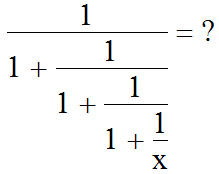 | \f{1; 1+\f{1; 1+\f{1; 1+\f{1; x}}}}=? | 17 seconds | 1 minute |
 | \s{2x+y=3; x-y>=3; \f{1;x}+\r{y}=2; 2x-5=6; x-x*y<>0} | 27 seconds | > 2 minutes |
 | \a{B}+\a{C}+\a{A}=180° | 12 seconds | not writable |
Getting started
Installation
In order to be able to use the Mathematics Toolbar, you need to proceed to the following:
- You must permit the execution of macros. In menu Tools, then Macros, then Security, go to the second tab and make sure to check the box Trust Visual Basic Project (or something similar)
- You first need to install it to a special location so that it will be
automatically loaded by Microsoft Word on its startup. Usually, this location is
C:\Documents and Settings\UserName\Application Data\Microsoft\Word\Startup. To be sure, just open the template document, it should tell you where to copy it. - Verify that the template is a global template. To do so, in the « Tools » menu, click on « Templates and addons » (or something similar, I don't have Word in English), then verify that the checkbox for the template is effectively checked.
- You must then restart Microsoft Word. If everything went right, you should have a new button called Maths in the standard command bar.
Writing your first formula
In this example, we will write a formula containing fractions. The last term of the formula will be outlined because it's a result and we want to make it visible.
Say the rendered formula should be:

- First, click on the « Maths » button in the Standard Toolbar. This should show the Mathematics Toolbar.
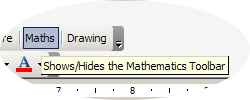
- Then, click on the « Fraction » button on the Mathematics Toolbar. This should insert the token
\f{;}.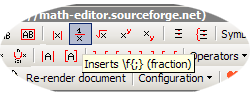
- Type
1(the numerator) in the first field ot the token, then3(the denominator) in the second field. - Put the cursor after the brace bracket
}, then type+. - Click on the « Fraction » button again and type
1and4in the respective fields. - Put the cursor after the brace bracket
}, type the equal sign, and continue the work until you reach the last equal term. - We want the last term to be outlined, so that it gets more visible. To do so, click on the « Box » button, then write the last fraction.
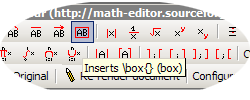
- You are almost done. You just then need to select the entire formula using the keyboard or your mouse and press the « Render » button. If something went wrong, don't worry, the Mathematics Toolbar should tell you where you made a mistake.
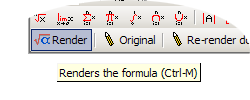
- Say you are not satisfied with your formula. You can reedit it by selecting it, then by clicking on the « Original » button.
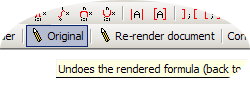
Description of supported tokens
A token can be defined as a combination of letters with a special meaning to the Mathematics Toolbar. Usually, a token is like the following:
- The
\(backslash) character - A word
- An opening brace bracket
{ - Zero or more semicolons used for argument splitting (zero if there is only one argument, N if there is N+1 argument)
- A closing brace bracket
}
There are two exceptions. The Exposure and Indice tokens do not have the backslash character and the word is replaced by ^ (hat) and _ (underscore) respectively.
The following table describes the currently supported tokens. If some tokens do not meet your needs, please tell me and I'll add the requested ones.
| Token | Description | Example |
|---|---|---|
| \a{} | Angle | \a{ABC} |
| \arc{} | Arc | \arc{AB} |
| \b{} | Bar | \b{AB} |
| \v{} | Vector | \v{AC} |
| \box{} | Box (outline) | \box{some words} |
| \abs{} | Absolute Value | \abs{x} |
| \f{;} | Fraction; 2 arguments | \f{2;3} |
| \r{} | Square root | \r{x} |
| ^{} | Exposure; you can omit the brackets if the argument is simple, such as a number for example | x^2 + x^{x+y} |
| _{} | Indice; you can omit the brackets if the argument is simple, such as a number for example | x_0 = 1 |
| \l{;...;} | Stacked lines; 1 argument per line; 2 arguments or more | \l{x + y = 3; x - y = 2} |
| \s{;...;} | System; 1 argument per line; 2 arguments or more | \s{x + y = 3; x - y = 2} |
| \r{;} | (College only) N Root; first argument is N; second argument is expression | \r{3;x} |
| \lim{;} | (College only) Limit | \lim{x->0;ln(x)} |
| \fmin{;;} | (College only) Generic function with index | \fmin{min;x€[0;1];x^2-x} |
| \fmax{;;} | (College only) Generic function with exposure | |
| \fminmax{;;;} | (College only) Generic function with index and exposure | \fminmax{some symbol;i=1;n;x^i-x} |
| \sum{;;} | (College only) Sum | \sum{i=0;n;x^i} |
| \prod{;;} | (College only) Product | \prod{i=0;n;i^2} |
| \int{;;} | (College only) Integral | \int{0;1;x} |
| \inter{;;} | (College only) Intersection | \inter{i=0;n;A_i} |
| \union{;;} | (College only) Union | \union{i=0;n;A_i} |
| \detX{;...;} | (College only) Determinant; X is the number of columns; number of lines is deducted from number of arguments | \det2{1;2;3;4;5;6} |
| \matX{;...;} | (College only) Matrix; X is the number of columns; number of lines is deducted from number of arguments | \mat2{1;2;3;4;5;6} |
| \open{;} | (College only) Range opened left and right | \open{0;1} |
| \close{;} | (College only) Range closed left and right | \close{0;1} |
| \openl{;} | (College only) Range opened left and closed right | \openl{0;1} |
| \openr{;} | (College only) Range closed left and opened right | \openr{0;1} |
| <> | Operator Differ | 1 <> 2 |
| ~= | Operator About Equal | 1.0001 ~= 1 |
| <= | Operator Less or Equal | x <= 2 |
| >= | Operator Greater or Equal | x >= 2 |
| <=> | Operator Equivalent | x^2=0 <=> x=0 |
| => | Operator Implies | x^3=1 => x=1 |
| -> | Operator Arrow (for limits) | \lim{x->0;ln(x)} |
| |-> | Operator Associate (for alternate function definitions) | f:x|->x^2 |

